Feature
The One Thing Still Standing
After a devastating windstorm in eastern Iowa, Lutherans hold onto the thing that cannot be moved.
“You’ve got to have faith to make this kind of living. … What God sends you, you’re living off of that,” says Eric Franzenburg.
The skeletons of Franzenburg’s greenhouses stand mangled in a row behind him. Through the empty places where their siding once was, bright flowers stick out here and there from wind-beaten plants.
Trusting God Amid Loss in Rural Iowa
“The thing about selling flowers is that they need to look perfect,” says Franzenburg, who raises flowers, vegetables and herbs, in addition to corn and beans. “We might be able to salvage a few of these for bouquets, and that will help.”
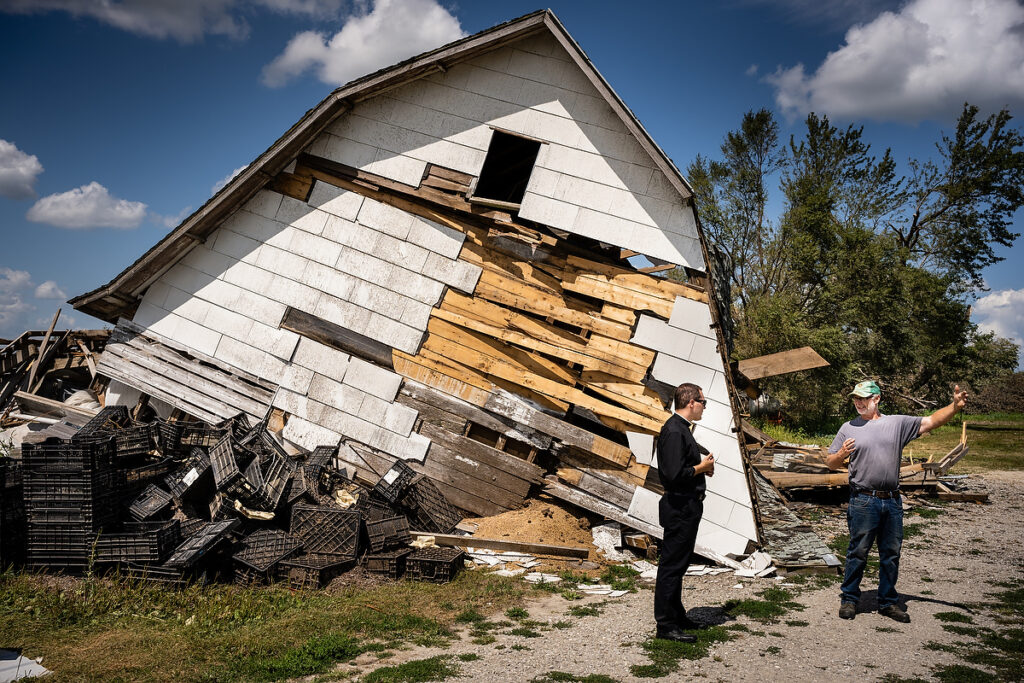
Franzenburg has never seen a storm like this. His 81-year-old father has never seen a storm like this, either. Most farmers across this stretch of eastern Iowa would doubtless say the same.
The “derecho” windstorm that tore through Iowa on Aug. 10 brought hurricane-force straight-line winds of up to 112 mph. Within half an hour, the rural landscape changed, as flattened and crushed barns, silos and farm equipment were spread across fields not only in Keystone, where Franzenburg lives, but across the state. Millions of acres of corn and soybeans were destroyed.
“Those trailers were over there when the storm started,” Franzenburg says, gesturing toward a place 20 feet out in a bean field. Now they sit against the edge of the field, one on its side, the other’s wheels facing the sky. An old corn crib lies crumbled, its roof resting atop a heap of timber, broken crates and spilled beans.
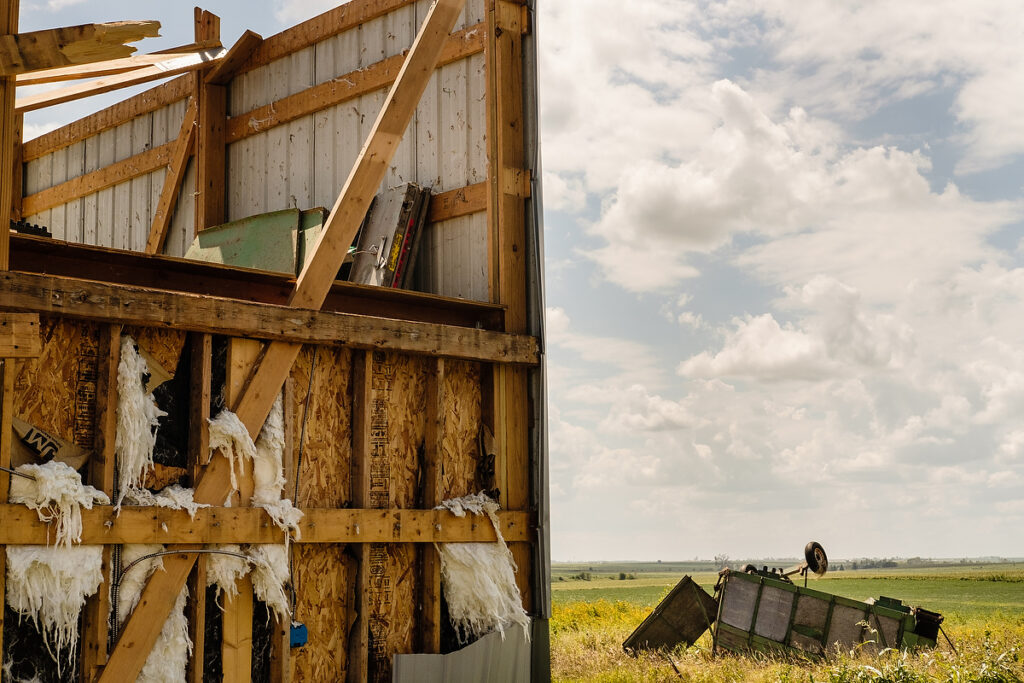
After the storm passed, the community of Keystone immediately got to work. In this farm community, the residents had access to tractors and equipment for clearing trees and rubble, and they wasted no time in doing so. Within a week of the storm, the trees and debris that had filled streets and yards in Keystone had been mostly cleared away. Neighbors helped neighbors without having to be asked.
“This is right in their wheelhouse, this is how they take care of each other,” says the Rev. Andy Wright, pastor of St. John Lutheran Church in Keystone. “This is part of their life here. They understand this.”
In a place where the COVID-19 pandemic had already wrought many changes, the storm brought even more. What could be blown away, was. But for Franzenburg and the other members of St. John, the most important thing could not be blown away.
On the Sunday morning following the storm, Wright led Franzenburg and over 50 other members, a sizable portion of St. John’s membership, in a worship service — as he had the week before. Gathered in the sanctuary the week before, the congregation had sung the hymn “What Is the World to Me.” Now, as he looked out at his congregation, the words to that hymn rang again in Wright’s ears.
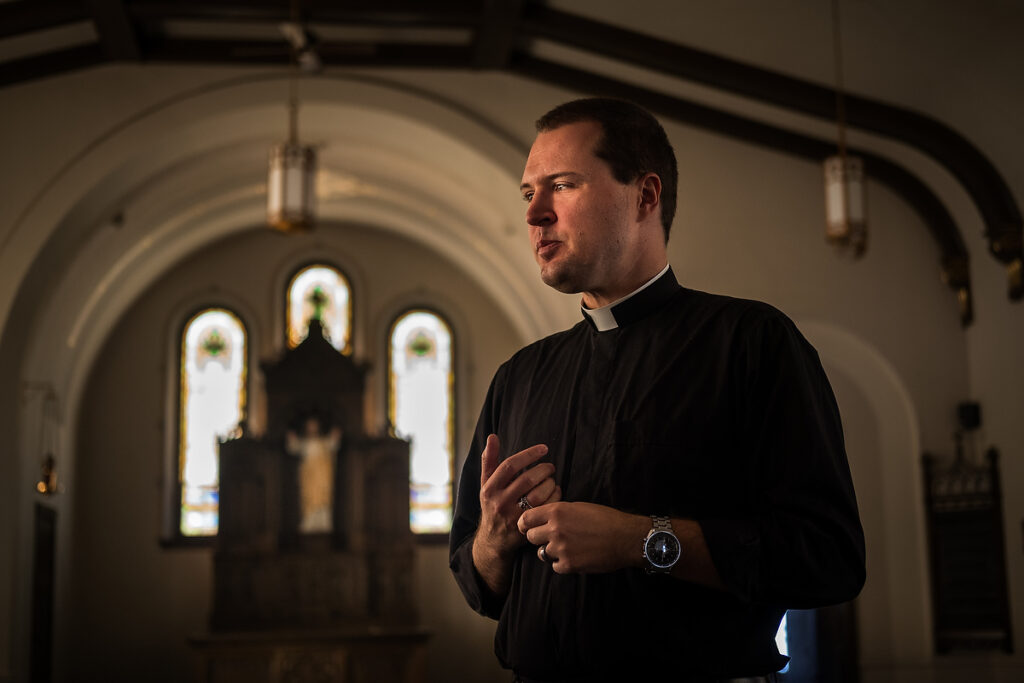
“We went from singing that hymn and talking about the things of this world and mammon, to the next day, most of these people’s mammon was gone. And yet: ‘What is the world to me … Jesus is my treasure … my peace, my rest.’ And to think about that as we were gathering again on Sunday, having lived through the storm — it brought us back to that very thing,” says Wright.
Unlike the week before, this Sunday they were gathered outside on the lawn. They could see the large hole the storm had blown through the sanctuary roof. For now, the congregation would have to find other ways to gather for church. And they did.
“I could have done a million other things, but I knew that I had to go to church,” says Franzenburg. “It was the Holy Spirit telling me, ‘This is it. You need to be there.’ … There are a lot of distractions. They’re there every day, but it’s even worse now. And that’s the time when you feel like you’ve got to get back to where you belong.”
Inside St. John’s sanctuary, a tarp covers the railings in front of the altar. Although the ceiling beneath the damaged roof still holds, streaks from the rain are visible down the walls. Cracks are forming. Above the altar, a statue of Jesus stands with arms outstretched.
Wright surveys his empty sanctuary. A week after the storm the power is still off, and windows are open to let cool air in.
“As we see and look around at the destruction and rubble, what gives us comfort is that our God is not just sitting on His throne, watching all of this happen,” says Wright. “Our God is the God who died and was laid in the tomb. It comforts us to know that God is not far — He’s near. As we’re gathering around His Word, He’s right here with us.”
Holding onto the Mission at Central Lutheran School
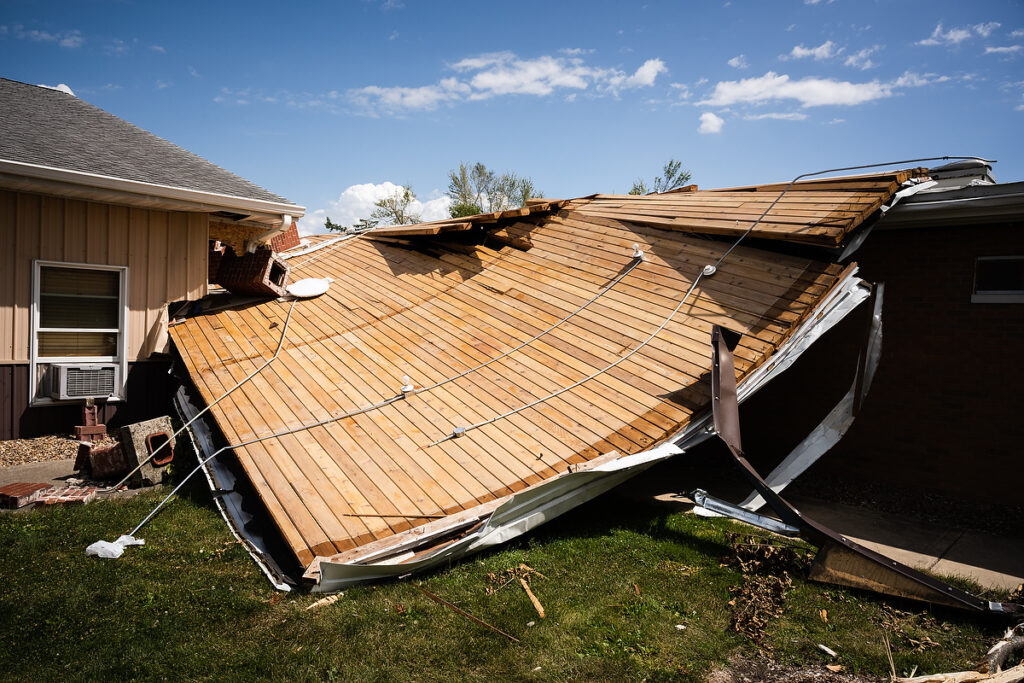
Sixteen miles down the road in Newhall, Iowa, Frank Parris, principal of Central Lutheran School, is standing next to what used to be the roof of one of the school’s gyms. Now part of that roof lies upside down in a courtyard outside. The other half crashed through the wall of a neighbor’s house.
“Of all the years I’ve been here, the teachers were really ready to go this year, after everything with COVID. A lot of them had their classrooms ready,” says Parris.
Six of those teachers were in the school building preparing their classrooms when the storm hit. It quickly became clear that this was much more than a typical summer thunderstorm, but it was too late to leave. Gathered together in a hallway, the teachers heard the gym roof torn from the building. Through a window, they saw part of it fly across the neighbor’s lawn. Then they started to smell the gas leak.
“Finally after the storm, I got in contact with the teachers who were inside,” says Parris. “‘We want out, we can’t get out, we want out,’ they kept saying.”
As he recounts this story, Parris picks up a sign from amid the rubble and scattered classroom materials next to the roof. “Give thanks to the Lord,” reads the sign, handwritten by a student in marker and smudged from the rain.
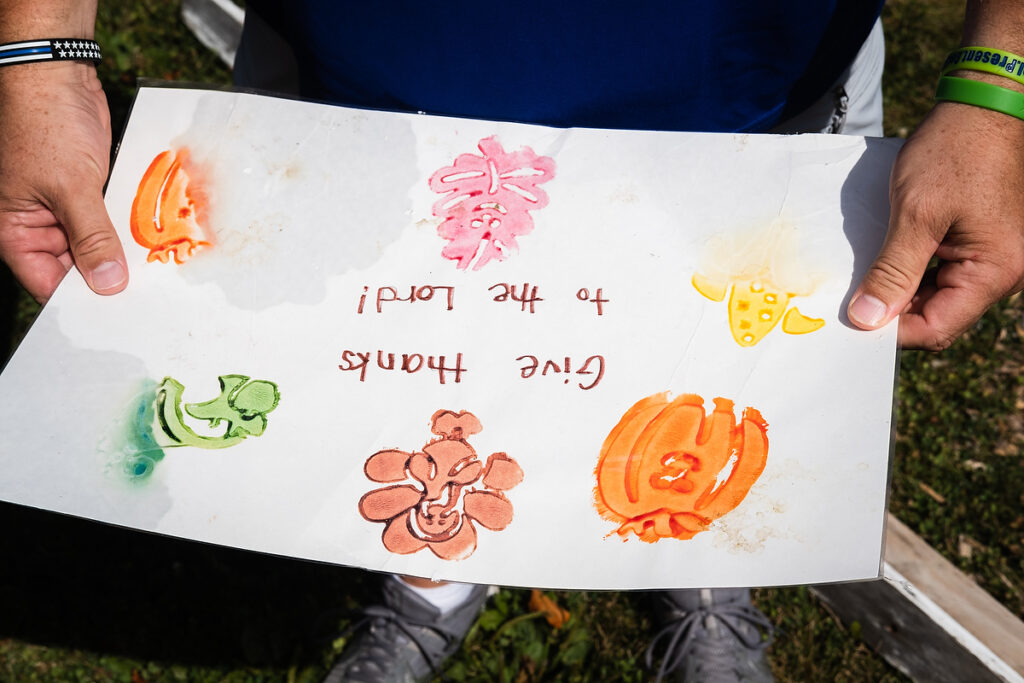
“It reminds you that we need to give thanks to the Lord, even now,” says Parris. “Because it could have been worse.”
A member of the school community came with a truck after the storm let up and got all of the teachers out safely. No one was injured.
Parris was sitting in his truck outside his house for the duration of the storm. After it passed, it looked like everything had changed. But he was quickly reminded that one thing hadn’t.
“I saw a tree fallen onto my porch and leaning on the house, and things were knocked every which way. And then I saw that the one thing still standing was the white cross that some of our teachers gave me after my father passed away. When I saw that cross, I was like, ‘OK, I’m done crying now.’ It made me refocus: That’s what really matters.”
As the school works to rebuild and to remake their plans for the beginning of this school year, Parris is grateful that they can continue to pursue what they always have: “We have a mission statement: to assist our parents and congregations in preparing our children to be disciples here and in the life to come. It’s still the same mission. We’ve just got to figure out how to do it in these different circumstances.”
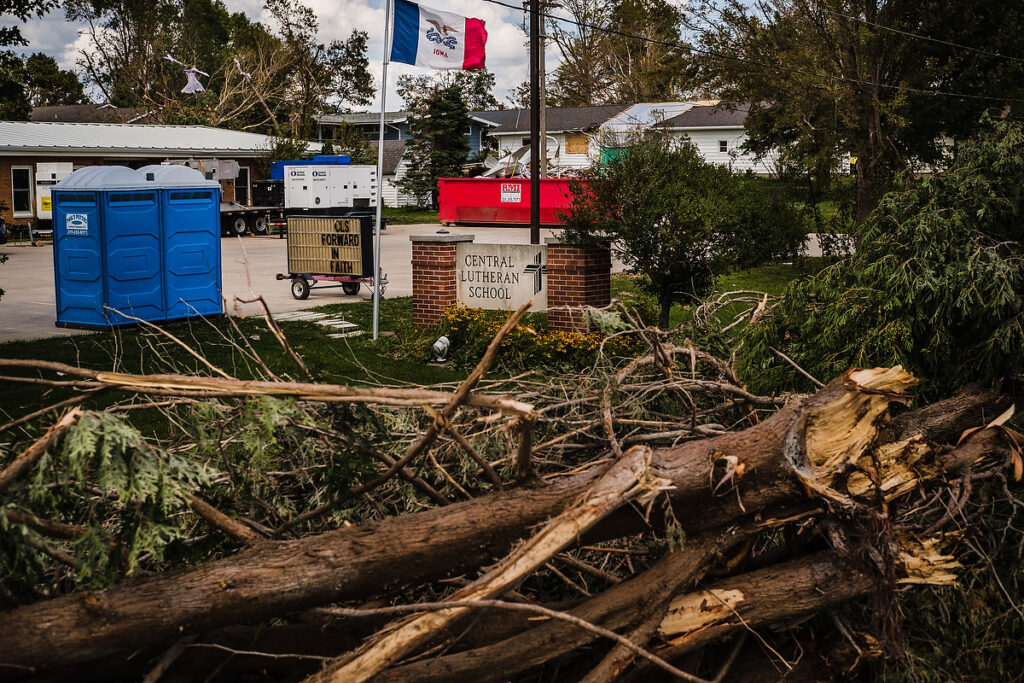
Clearing Trees in Cedar Rapids
The sound of chainsaws fills the air next to Concordia Lutheran Church in Cedar Rapids, Iowa. Lutheran Early Response Team (LERT) members call out as the last tree still standing on Concordia’s lot slowly leans and then crashes to the ground. Around it lie pieces of the many trees felled by the storm’s winds, which the team has cut up to be hauled away.
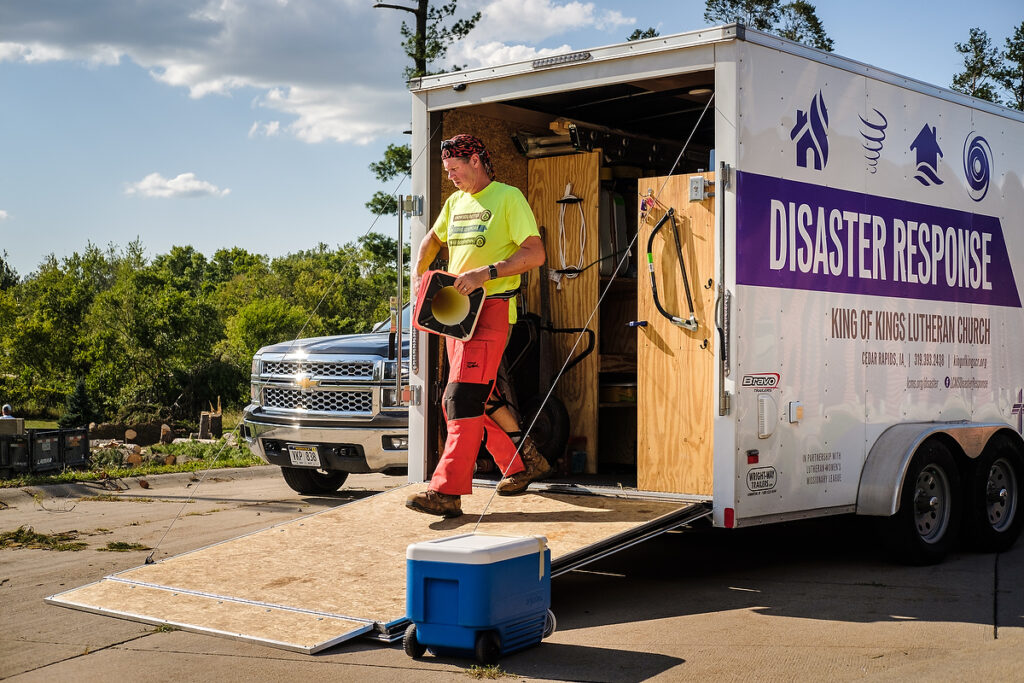
Cedar Rapids, the second-largest city in Iowa, is inside the region of Iowa that saw the fastest and most damaging winds during the storm. A week later, trees are down everywhere. Some still rest on houses, where they fell. Homes, businesses and properties in every direction are missing shingles, siding, parts of their roofs. In many places, brand-new power poles already stand where the old ones were splintered.
Within an hour of the storm, LERT volunteers from LCMS Iowa District East (IDE) were on the scene. By the next week, LERT members and other volunteers came from multiple states to assist in the recovery efforts.
“If we can get our churches up and running, and our church workers up and running, that’s a key priority. But then there’s finding people who can’t get their power on until they get their trees out of the way,” says Daniel Sanchez, IDE assistant district disaster-response coordinator.
Sanchez is also director of Camp Io-Dis-E-Ca near Solon, Iowa, which is offering food and lodging for the LERT members and other volunteers, funded by grant money from LCMS Disaster Response.
From Concordia’s parking lot, IDE President Rev. Dr. Brian Saunders watches the chainsaw team work. He says that it looks like this in his own neighborhood and all over town right now — trees piled up so high on every corner that it looks almost like an Iowa winter, when the streets are lined with plowed snow.
“It’s a test to our resolve,” says Saunders. “Are we going to hold onto and trust God [that] what He says is true? And that is that the God of storm and wind is also the Lord of life and salvation.”
The storm hit congregations especially hard after months of difficulties related to the pandemic. But it has not taken away, and cannot take away, the things that are most essential to the church — and this very fact is the church’s greatest witness, Saunders says.
“These are times when the church has more opportunity than ever to witness to what it believes and confesses is true. That’s where I, as the district president, am encouraging our pastors to lay out before our congregations the importance of Divine Service,” says Saunders. “Whether it’s COVID, whether it’s no electricity, whether it’s tree damage, stand up and tell the community: The most important thing in our life is to receive the gifts of God in this place.”
Learn More
- Support the Synod’s disaster-response efforts.
- Learn more about LCMS World Relief and Human Care Disaster Response.
Pray with Us
Almighty God, You breathed Your Spirit into Adam, and he became a living creature. You continue to send Your Spirit to Your people through Your Word and Sacraments. Yet, we do not know from where the wind blows or where it will blow again. We pray You would strengthen those who continue to recover from storms and other trials. We thank You for Your provision through neighbors near and far. But most of all, we rejoice that in the cross of Jesus Christ You are with Your people in the midst of storm and tempest, and that You forgive and restore Your people each week as we gather around Your Means of Grace. We pray this in the name of Your Son, our Savior, Jesus Christ. Amen.
Share Jesus with the World
Your generosity today makes possible your Synod’s witness and mercy efforts both at home and abroad.
Are you looking to direct your gifts for work that’s more specific?
Visit the LCMS online ministry and mission catalog to find those opportunities most meaningful to you!
Don’t see what you’re looking for?
Contact LCMS Mission Advancement at 888-930-4438 or mission.advancement@lcms.org to talk about all the options available.
Stacey Eising
Managing editor for The Lutheran Witness.

